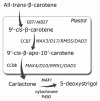The role of strigolactones in nutrient-stress responses in plants
- PMID: 23629665
- PMCID: PMC3676783
- DOI: 10.3390/ijms14059286
The role of strigolactones in nutrient-stress responses in plants
Abstract
Strigolactones (SLs) are a new group of plant hormones, which have been intensively investigated during the last few years. The wide spectrum of SLs actions, including the regulation of shoot/root architecture, and the stimulation of the interactions between roots and fungi or bacteria, as well as the stimulation of germination of parasitic plants, indicates that this group of hormones may play an important role in the mechanisms that control soil exploration, and the root-mediated uptake of nutrients. Current studies have shown that SLs might be factors that have an influence on the plant response to a deficiency of macronutrients. Experimental data from the last four years have confirmed that the biosynthesis and exudation of SLs are increased under phosphorus and nitrogen deficiency. All these data suggest that SLs may regulate the complex response to nutrient stress, which include not only the modification of the plant developmental process, but also the cooperation with other organisms in order to minimize the effects of threats. In this paper the results of studies that indicate that SLs play an important role in the response to nutrient stress are reviewed and the consequences of the higher biosynthesis and exudation of SLs in response to phosphorus and nitrogen deficiency are discussed.
Figures
Similar articles
-
Nitrogen and phosphorus fertilization negatively affects strigolactone production and exudation in sorghum.Planta. 2013 Nov;238(5):885-94. doi: 10.1007/s00425-013-1943-8. Epub 2013 Aug 8. Planta. 2013. PMID: 23925853
-
Regulation of Root Development and Architecture by Strigolactones under Optimal and Nutrient Deficiency Conditions.Int J Mol Sci. 2018 Jun 27;19(7):1887. doi: 10.3390/ijms19071887. Int J Mol Sci. 2018. PMID: 29954078 Free PMC article. Review.
-
How Do Strigolactones Ameliorate Nutrient Deficiencies in Plants?Cold Spring Harb Perspect Biol. 2019 Aug 1;11(8):a034686. doi: 10.1101/cshperspect.a034686. Cold Spring Harb Perspect Biol. 2019. PMID: 31088825 Free PMC article. Review.
-
Fine-tuning by strigolactones of root response to low phosphate.J Integr Plant Biol. 2016 Mar;58(3):203-12. doi: 10.1111/jipb.12454. Epub 2016 Feb 26. J Integr Plant Biol. 2016. PMID: 26667884 Review.
-
Strigolactones can be a potential tool to fight environmental stresses in arid lands.Environ Res. 2023 Jul 15;229:115966. doi: 10.1016/j.envres.2023.115966. Epub 2023 Apr 24. Environ Res. 2023. PMID: 37100368 Review.
Cited by
-
The Complex Interplay between Arbuscular Mycorrhizal Fungi and Strigolactone: Mechanisms, Sinergies, Applications and Future Directions.Int J Mol Sci. 2023 Nov 26;24(23):16774. doi: 10.3390/ijms242316774. Int J Mol Sci. 2023. PMID: 38069097 Free PMC article. Review.
-
Effects of strigolactone signaling on Arabidopsis growth under nitrogen deficient stress condition.Plant Signal Behav. 2016;11(1):e1126031. doi: 10.1080/15592324.2015.1126031. Plant Signal Behav. 2016. PMID: 26653175 Free PMC article.
-
Molecular and Systems Biology Approaches for Harnessing the Symbiotic Interaction in Mycorrhizal Symbiosis for Grain and Oil Crop Cultivation.Int J Mol Sci. 2024 Jan 11;25(2):912. doi: 10.3390/ijms25020912. Int J Mol Sci. 2024. PMID: 38255984 Free PMC article. Review.
-
Perception and Signaling of Strigolactones.Front Plant Sci. 2016 Aug 23;7:1260. doi: 10.3389/fpls.2016.01260. eCollection 2016. Front Plant Sci. 2016. PMID: 27602041 Free PMC article. Review.
-
Shoot-derived signals other than auxin are involved in systemic regulation of strigolactone production in roots.Planta. 2015 Mar;241(3):687-98. doi: 10.1007/s00425-014-2208-x. Epub 2014 Nov 23. Planta. 2015. PMID: 25417194
References
-
- Cook C.E., Whichard L.P., Turner B., Wall M.E., Egley G.H. Germination of witchweed (Striga luteaLour.): Isolation and properties of a potent stimulant. Science. 1966;23753:1189–1190. - PubMed
-
- Akiyama K., Matsuzaki K., Hayashi H. Plant sesquiterpenes induce hyphal branching in arbuscular mycorrhizal fungi. Nature. 2005;7043:824–827. - PubMed
-
- Yoneyama K., Xie X., Sekimoto H., Takeuchi Y., Ogasawara S., Akiyama K., Hayashi H., Yoneyama K. Strigolactones, host recognition signals for root parasitic plants and arbuscular mycorrhizal fungi, from Fabaceae plants. New Phytol. 2008;179:484–494. - PubMed
-
- Gomez-Roldan V., Fermas S., Brewer P.B., Puech-Pagès V., Dun E.A., Pillot J.P., Letisse F., Matusova R., Danoun S., Portais J.C., et al. Strigolactone inhibition of shoot branching. Nature. 2008;455:189–194. - PubMed
-
- Umehara M., Hanada A., Yoshida S., Akiyama K., Arite T., Takeda-Kamiya N., Magome H., Kamiya Y., Shirasu K., Yoneyama K., et al. Inhibition of shoot branching by new terpenoid plant hormones. Nature. 2008;455:195–200. - PubMed
Publication types
MeSH terms
Substances
LinkOut - more resources
Full Text Sources
Other Literature Sources



